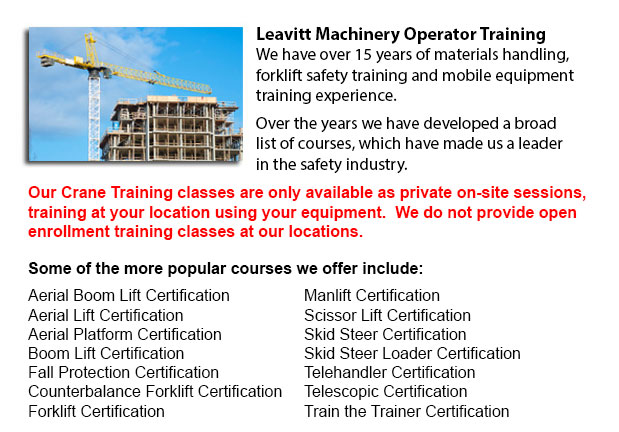
Crane Certification Whitby - The Crane Certification Program includes the industry suggested subject matter that would teach the safe and efficient operation of cranes. The person will train in the following: pre-operational, operational and post operating requirements; how to identify cranes and their component parts; rigging components and inspection/rejection criteria; how to determine overall lift capacity; and requirements particular to the work location where the trainees will be working.
Pre-operational requirements consist of assigning authority for the pre-operational check; performing the sequential pre-operational check based on the specifications certified by a professional engineer or manufacturer's specifications; inspecting the work place for hazards and obstacles; checking the log book for comments; inspecting chains, cables, hooks safety latches and crane movement; ensuring the correct functioning of operational controls; and learning how to ensure the crane's disconnect switch/isolator is working properly.
The requirements to operating a crane would comprise the identifying of responsibilities and roles, and the determination of the requirement for a formal lift plan. The person training would be taught how to do hazard assessments for the varying environmental conditions, physical conditions and workers. Subject matter includes determining when to seek competent support, the safest route and destination of loads, and centre of gravity and load weight.
It is very important for individuals training to be able to identify an over-capacity lift, choose correct rigging machine, know load limitations, and determine a safe place from which to operate. Trainees will review both universal and site-specific crane signals for lifts, and techniques for lifting, loading and traveling. Proper maintenance habits will be included.
The individuals training will undergo an examination to test their understanding of emergency response techniques for different scenarios, specially electrical or mechanical failures. They would be asked to describe parking and shut down procedures for safety and security, to follow tagging and lock out techniques, and to explain why near misses are reported and recorded to the appropriate individual. Log book records should be maintained.
The individual training will be taught the particulars of rigging, and know the authority and responsibility for rigging. They will know to identify the various kinds of rigging, storage procedures and the load capacity ratings.
Post-operational requirements include entering defects or deficiencies, service and maintenance history in the log book, according to provincial, federal and state codes requirements.
Site-specific requirements can be included into the safety training program based on the employer's requirements.
-
Wheel Loader Operator Training Whitby
Wheel Loader Operator Training Whitby - To be able to lift considerable loads, industrial cranes use levers and pulleys. In the past, Roman people used cranes to be able to erect large monuments making the origin of these equipment at least two thous... More -
Aerial Lift / Boom Lift / Man Lift / Scissor Lift Training in Whitby
Scissor lifts are lift truck tables which lift up materials and people and supplies vertically. They are normally utilized in commercial, industrial and construction environments. A common use of scissor lifts is for lifting or lowering construction... More -
Manlift Operator Training Whitby
Manlift Operator Training Whitby - A specialized kind of hydraulic platform is called an aerial lift or a man lift. It is intended to lift an individual vertically up and down and thus, is likewise known as a vertical personnel lift. This machinery i... More -
Aerial Lift Ticket Whitby
Aerial Lift Ticket Whitby - A boom truck is frequently recognized by the cable and telephone business vans that have the extended arm folded over their roofs. Commonly, a bucket-like apparatus sits at the extension of extendable arms. Often known as... More -
Crane Training Whitby
Crane Training Whitby - Overhead cranes are otherwise known as bridge cranes. They are a kind of crane which has a line and hook mechanism which runs along a horizontal beam which runs along two widely separated rails. Numerous overhead cranes could... More -
Forklift Certification Schools Whitby
Forklift Certification Schools Whitby - Within North America, forklift certification is mandatory, making forklift training programs essential for both the company and their employees working as operators of forklifts. Forklift training focuses on he... More -
Crane Safety Training Whitby
Crane Safety Training Whitby - Companies and crane drivers need to be aware of the issues connected to crane safety. Legislation provides rules for the safe operation, inspection and maintenance of lifting machinery all around North America. Crane Sa... More -
Overhead Crane Certification Whitby
Overhead Crane Certification Whitby - The overhead crane certification course is a course that is designed to assist trainees, even if they have literacy or language restrictions. The program consists of a classroom theory part and a practical hands-... More

Forklift Training Whitby
TOLL FREE: 1-888-254-6157
Whitby, Ontario
forklifttrainingwhitby.com
Email Us
About Us


